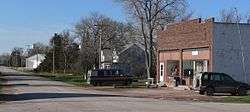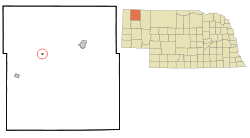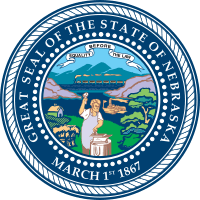Whitney, Nebraska
Whitney is a village in Dawes County, Nebraska, United States. The population was 77 at the 2010 census.[6]
Whitney, Nebraska | |
|---|---|
 Downtown Whitney | |
 Location of Whitney, Nebraska | |
| Coordinates: 42°47′2″N 103°15′26″W | |
| Country | United States |
| State | Nebraska |
| County | Dawes |
| Area | |
| • Total | 0.16 sq mi (0.41 km2) |
| • Land | 0.16 sq mi (0.41 km2) |
| • Water | 0.00 sq mi (0.00 km2) |
| Elevation | 3,412 ft (1,040 m) |
| Population | |
| • Total | 77 |
| • Estimate (2019)[3] | 72 |
| • Density | 455.70/sq mi (176.13/km2) |
| Time zone | UTC-7 (Mountain (MST)) |
| • Summer (DST) | UTC-6 (MDT) |
| ZIP code | 69367 |
| Area code(s) | 308 |
| FIPS code | 31-52925[4] |
| GNIS feature ID | 0835709[5] |
History
Originally called Dawes City, then Earth Lodge, it was renamed in honor of Peter Whitney, a railroad official.[7][8] East of Whitney is the site of Old Fort Useless, built for settlers' protection but never used.[9]
Whitney was incorporated as a village in 1888.[10]
Geography
Whitney is located at 42°47′2″N 103°15′26″W (42.784024, -103.257281).[11] According to the United States Census Bureau, the village has a total area of 0.16 square miles (0.41 km2), all land.[12]
Demographics
| Historical population | |||
|---|---|---|---|
| Census | Pop. | %± | |
| 1930 | 177 | — | |
| 1940 | 154 | −13.0% | |
| 1950 | 132 | −14.3% | |
| 1960 | 98 | −25.8% | |
| 1970 | 82 | −16.3% | |
| 1980 | 72 | −12.2% | |
| 1990 | 38 | −47.2% | |
| 2000 | 87 | 128.9% | |
| 2010 | 77 | −11.5% | |
| Est. 2019 | 72 | [3] | −6.5% |
| U.S. Decennial Census[13] | |||
2010 census
As of the census[2] of 2010, there were 77 people, 37 households, and 25 families residing in the village. The population density was 481.3 inhabitants per square mile (185.8/km2). There were 39 housing units at an average density of 243.8 per square mile (94.1/km2). The racial makeup of the village was 88.3% White, 2.6% African American, 3.9% from other races, and 5.2% from two or more races. Hispanic or Latino of any race were 11.7% of the population.
There were 37 households of which 21.6% had children under the age of 18 living with them, 56.8% were married couples living together, 8.1% had a female householder with no husband present, 2.7% had a male householder with no wife present, and 32.4% were non-families. 27.0% of all households were made up of individuals and 13.5% had someone living alone who was 65 years of age or older. The average household size was 2.08 and the average family size was 2.44.
The median age in the village was 49.2 years. 16.9% of residents were under the age of 18; 7.8% were between the ages of 18 and 24; 15.6% were from 25 to 44; 33.8% were from 45 to 64; and 26% were 65 years of age or older. The gender makeup of the village was 49.4% male and 50.6% female.
2000 census
As of the census[4] of 2000, there were 87 people, 34 households, and 24 families residing in the village. The population density was 551.2 people per square mile (209.9/km2). There were 40 housing units at an average density of 253.4 per square mile (96.5/km2). The racial makeup of the village was 97.70% White, 2.30% from other races. Hispanic or Latino of any race were 2.30% of the population.
There were 34 households out of which 32.4% had children under the age of 18 living with them, 55.9% were married couples living together, 11.8% had a female householder with no husband present, and 29.4% were non-families. 17.6% of all households were made up of individuals and 11.8% had someone living alone who was 65 years of age or older. The average household size was 2.56 and the average family size was 2.92.
In the village, the population was spread out with 28.7% under the age of 18, 4.6% from 18 to 24, 24.1% from 25 to 44, 24.1% from 45 to 64, and 18.4% who were 65 years of age or older. The median age was 39 years. For every 100 females, there were 102.3 males. For every 100 females age 18 and over, there were 106.7 males.
As of 2000 the median income for a household in the village was $28,333, and the median income for a family was $20,625. Males had a median income of $11,667 versus $10,625 for females. The per capita income for the village was $11,107. There were 22.2% of families and 13.7% of the population living below the poverty line, including 6.7% of under eighteens and none of those over 64.
References
- "2019 U.S. Gazetteer Files". United States Census Bureau. Retrieved July 26, 2020.
- "U.S. Census website". United States Census Bureau. Retrieved 2012-06-24.
- "Population and Housing Unit Estimates". United States Census Bureau. May 24, 2020. Retrieved May 27, 2020.
- "U.S. Census website". United States Census Bureau. Retrieved 2008-01-31.
- "US Board on Geographic Names". United States Geological Survey. 2007-10-25. Retrieved 2008-01-31.
- http://www.rapidcityjournal.com/thechadronnews/news/article_0bfc2de8-943e-5790-a008-f492b9e21542.html
- Fitzpatrick, Lillian L. (1960). Nebraska Place-Names. University of Nebraska Press. p. 50. A 1925 edition is available for download at University of Nebraska—Lincoln Digital Commons.
- Chicago and North Western Railway Company (1908). A History of the Origin of the Place Names Connected with the Chicago & North Western and Chicago, St. Paul, Minneapolis & Omaha Railways. p. 139.
- Federal Writers Project. (1939) Nebraska. Nebraska State Historical Society. p 321.
- "Whitney, Dawes County". Center for Advanced Land Management Information Technologies. University of Nebraska. Retrieved 4 August 2014.
- "US Gazetteer files: 2010, 2000, and 1990". United States Census Bureau. 2011-02-12. Retrieved 2011-04-23.
- "US Gazetteer files 2010". United States Census Bureau. Retrieved 2012-06-24.
- "Census of Population and Housing". Census.gov. Retrieved June 4, 2015.
